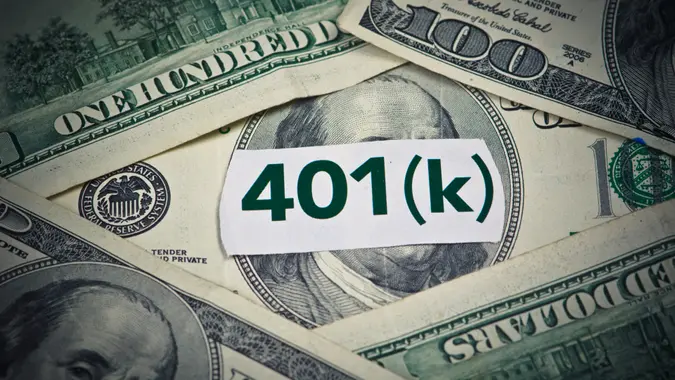What Would a $1 Million Retirement Look Like? Experts Weigh In

Commitment to Our Readers
GOBankingRates' editorial team is committed to bringing you unbiased reviews and information. We use data-driven methodologies to evaluate financial products and services - our reviews and ratings are not influenced by advertisers. You can read more about our editorial guidelines and our products and services review methodology.

20 Years
Helping You Live Richer

Reviewed
by Experts

Trusted by
Millions of Readers
Many Americans aren’t financially prepared for retirement. According to the Federal Reserve’s 2020 Report on the Economic Well-Being of U.S. Households, 25% of non-retirees indicated that they have no retirement savings, less than 40% felt that their retirement savings are on track, and nearly 60% of non-retirees with self-directed retirement savings expressed low levels of comfort about making retirement decisions.
If you’re one of the many Americans who are unsure about how much to save for retirement, read on to find out what experts think a $1 million retirement could look like and whether your nest egg is large enough for you to live a comfortable lifestyle in your golden years.
Is $1 Million Enough for Retirement?
“The safe withdrawal rule says you can take out 4% of your nest egg each year, with a small chance of running out of money. That would be $40,000 per year on $1 million,” said Jay Zigmont, PhD, MBA, CFP®, and the founder and CEO of Childfree Wealth®, a life and financial planning firm.
Whether this amount is enough to live a comfortable retirement lifestyle depends on various factors, which we’ll touch on later in the article. But, if you’re able to sustain yourself with $40,000 a year, a $1 million nest egg should be enough. Note that people ages 65 and older spent, on average, $52,141 in 2021, according to the Bureau of Labor Statistics.
Plus, depending on your situation, you may have to pay Uncle Sam a portion of your $40,000 annual retirement budget.
“Your investments and accounts will impact what taxes you pay on that $40k, ranging from zero percent coming out of a Roth account to your current income tax rate in a traditional account. Some states tax retirement income, while others don’t, which can also have a big impact,” Zigmont said.
Can You Travel With A $1 Million Nest Egg?
“Travel may be possible if the rest of your expenses are low and your travel budget is reasonable. However, you won’t be able to take $10,000 to $20,000 trips each year without cutting annual expenses considerably,” Zigmont said.
Also, whether travel is possible in your golden years will largely depend on the type of trips or vacations you’re planning to take. For example, a road trip from California to Texas will be much more affordable than a luxury cruise to Antarctica or a two-week vacation on the Amalfi Coast.
So, yes. Most retirees can afford to travel with a $1 million nest egg, but that doesn’t mean they’re shelling out thousands of dollars every few weeks on first-class flight tickets. More likely, they’re leaning toward budget-friendly travel options to make their retirement funds last as long as possible.
How Much Can You Spend On Housing With a $1 Million Nest Egg?
“There is no right answer to this question. A lot depends on a retired household’s total income, including withdrawals from the $1 million nest egg,” said Barbara O’Neill, Ph.D., CFP®, AFC®, CRPC® and an expert contributor for Annuity.org.
However, she believes a good rule to follow for spending on housing for people of all ages is to have a debt-to-income ratio of no more than 35% to 40%. Debt-to-income ratio is calculated by adding up all your monthly debt payments, including your mortgage, and dividing them by your gross monthly income.
For example: mortgage ($800) + car loan payment ($300) + credit card payments ($300) = $1,400 divided by monthly gross income ($4,000) = 0.35 or a debt-to-income ratio of 35%. In this case, if you’re spending over $1,000 a month on housing, then you could be overextending yourself financially, assuming your car payments, credit card payments and gross income stay the same.
So, let’s say your annual retirement budget is $40,000. To keep your debt-to-income ratio under the 35% to 40% range, your total annual debt payments, including your mortgage, should be under $14,000 to $16,000.
Factors That May Affect What Your $1 Million Retirement Looks Like
- Location: The amount of retirement funds you need to retire in Chiang Mai, Thailand, or in Memphis, Tennessee, will be much less than the amount you need to retire comfortably in an expensive city like Los Angeles.
- The Amount of Debt You Have: Carrying debt into retirement can negatively affect your financial flexibility, especially if you’re drowning in multiple high-interest debts. So, before ditching the 9-to-5 grind, make sure you’ve paid off most of your bad debts.
- Retirement Age: The earlier you retire, the longer your retirement funds will need to last. And if you start tapping your savings at an earlier age, you could potentially run out of money before reaching your golden years.
- Your Health Condition: If you suffer from chronic diseases like diabetes or other health problems, you may have to shell out a significant portion of your retirement fund for healthcare expenses. According to the Fidelity Retiree Health Care Cost Estimate, a single person age 65 in 2023 may need around $157,500 saved (after tax) to cover health care expenses in retirement.
- Retirement Benefits: Additional income sources, like pensions or Social Security, can complement your $1 million nest egg and make your retirement much more comfortable. According to the Social Security Administration (SSA), the average monthly retirement benefit for Social Security recipients is $1,860.23 as of January 2024.
How Much Should You Save For Retirement?
“For a rough number, multiply your current annual expenses by 25. That will tell you how much you need to save in order to retire and use the safe withdrawal rate. There are a bunch of other factors to consider, but it’s a good ballpark number to shoot for,” Zigmont said.
So, let’s say you spend $60,000 a year. The ideal amount you should have in your retirement fund is $1.5 million or more.
Fidelity Investments, a brokerage firm, estimates that saving 10 times your preretirement income by age 67 should ensure you have enough income to maintain your current lifestyle in retirement. In other words, if you currently make $120,000 annually, aim to save at least $1.2 million for retirement. Note that these guidelines are not strict rules but serve as a starting point to help build your savings plan.
Remember, it’s never too early to start saving for retirement. The sooner you start contributing to your nest egg, the more time you give compound interest to work its magic.
 Written by
Written by  Edited by
Edited by 

























